Pastels are in the spotlight at the Musée d’Orsay in Paris with the exhibition Pastels from Millet to Redon from 14 March to 2 July 2023, curated by Caroline Corbeau-Parsons, curator of graphic arts at the Musée d’Orsay.
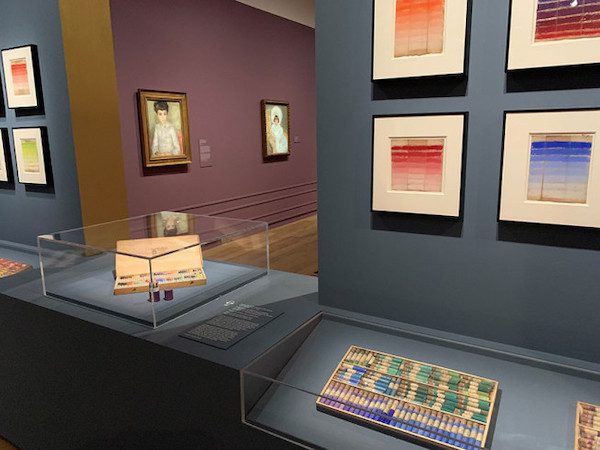
Probably invented in France and Italy at the end of the 15th century, pastels were highly prized in the 17th century for their frank colors, their ability to imitate the material of fabrics and to render the effects of skin tone in portraiture. But it is in the 18th century that it knows its golden age with Rosalba Carriera, Maurice Quentin de la Tour or Chardin qualified as “pastel painters“, before falling into disuse shortly after the French Revolution in favor of oil painting.
Between the second half of the 19th century and the beginning of the 20th century, it was used by the Impressionists and the Nabis, and experienced a real renaissance in the 1890s with the Symbolist movement, as this exhibition of ninety-five of the most important works in the Musée d’Orsay collection shows. The pastel technique was then freed from portraiture and extended to all subjects. It was used by many artists in their creative experiments as the most liberated means of artistic expression.
Eight major themes mark out the course of this exhibition, which opens with a presentation of pastel sticks and their composition made essentially of pure pigments: mineral (ochres, sienna) or organic (sepia, phthalocyanines, azo) or vegetable (dyer’s pastel), a charge : chalk or plaster that serves to give the pastel its texture and finally a binder that ensures consistency and conditions the hardness of the stick: gum arabic for dry pastels, oil or wax for fat pastel
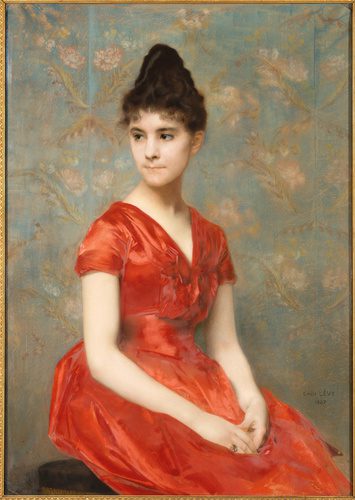
Pastel sur papier beige118,5/86,0 cm.
Mode d’acquisition inconnu, s.d.
© RMN-Grand Palais (Musée d’Orsay) / Hervé Lewandowski
The first room, Sociabilités, presents painters such as Émile Levy, Jacques-Emile Blanche and Louise Breslau, who are part of the tradition of aristocratic portraits painted in large formats. In Emile Levy’s Portrait of Marie de Hérédia, the pastel renders the richness of the scarlet and the shimmer of the satin of the dress. Manet for his part favors bust portraits like this Portrait of Irma Brunner or this Bust of a Nude Woman whose use of pastel sublimates the complexion.
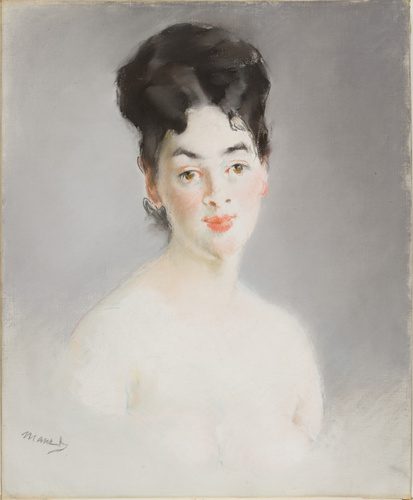
Pastel sur toile et châssis 53,5/44,6 cm.
Legs comte Isaac de Camondo, 1911
© Musée d’Orsay, Dist. RMN-Grand Palais / Patrice Schmidt
Terre et Mer illustrates the extension of the use of pastels to all genres, of which Millet was one of the pioneers. Harvesters, fishermen, churners (La baratteuse, ca. 1866) are captured in their daily activities and costumes. They take us back to a way of life marked by a certain nostalgia.
Modernités evoke the transformations caused by the upheavals of modern life, those that inspired the Impressionists for whom pastel became a privileged technique to capture this world in motion. Eugène Boudin captures the changing character of life in the open air, the effects of light by the sea, Deauville (Beach, 1862-1870), Trouville or Honfleur in Normandy, are an inexhaustible source of inspiration. Degas, considered as one of the pillars of pastel painting, having largely contributed to its development, used it almost exclusively from 1880-1890. This city painter took a neutral view of laundresses (La Repasseuse, 1869) and dancers (Deux danseuses au repos, circa 1910-1912).
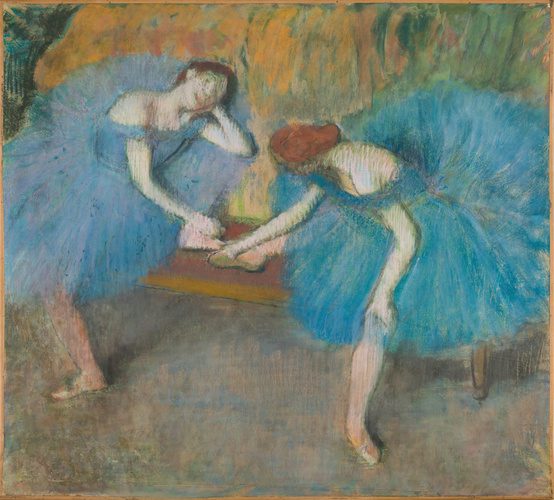
Pastel sur papier beige et châssis entoilé. H. 92,0 ; L. 103,0 cm.
Legs sous réserve d’usufruit Mme la baronne Eva Gebhard-Gourgaud, 1965
© Musée d’Orsay, Dist. RMN-Grand Palais / Patrice Schmidt
The fourth theme, addressed in Essence de la Nature, shows the interest of pastels for painters. Because of its small size, it allowed them to work in the open air but also to quickly transcribe the atmospheric changes and the effects of light at different times of the day. From Élisabeth Vigée Le Brun through Delacroix, admired for his skies by Corot, to the Impressionists and the Symbolists such as Lévy-Dhurmer, Medusa, also known as Vague Furieuse, 1897 (illustration of the header of the article), Rippl-Rónaï (Un parc la nuit, vers 1892-1895) or Odilon Redon (Fleur de Sang, 1895), each of them used this fragile and ephemeral medium to give a particular tone to the landscape.
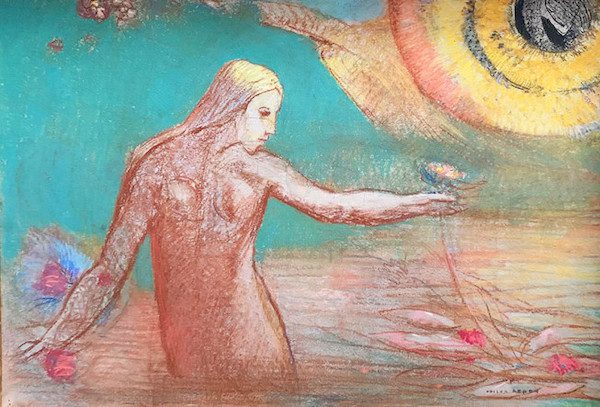
Legs Mme Arï Redon en exécution des volontés de son mari, fils d’Odilon Redon, 1982
© RMN-Grand Palais (Musée d’Orsay) / Hervé Lewandowski
Intérieurs emphasizes domestic life and genre scenes that reflect the values prized by the bourgeoisie. The portrait becomes the expression of a state of mind, of an interiority that the pastel expresses with nuance and delicacy and in which certain women excel: thus Mary Cassatt privileges the intimacy of the mother-child couple (Mother and Child on a Green Background 1897). Very attentive to the way in which the light plays on the bodies and objects Berthe Morisot often chooses her models in her entourage, (Portrait of Madame Edma Pontillon 1871), Louise Breslau realizes many portraits of children, (Little girl with a white dog also called Portrait of Miss Adeline Poznanska, 1891)
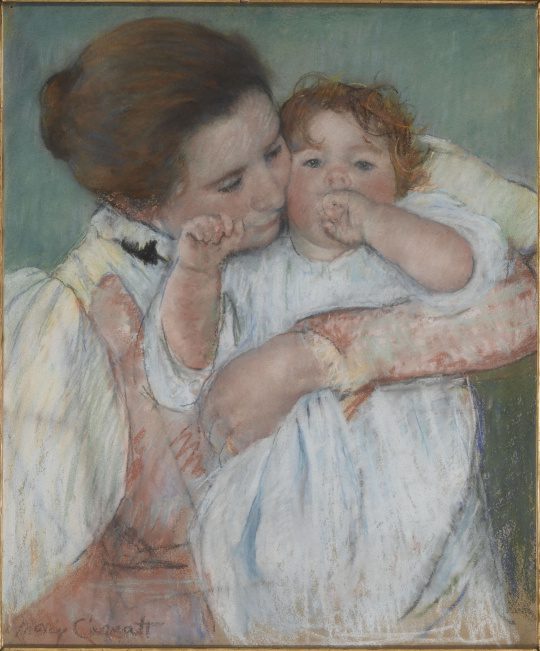
Pastel. Photo (C) RMN-Grand Palais (musée d’Orsay) / Hervé Lewandowski
In Intimité, pastel portraits seem to be more apt than any other medium to render the velvety texture of the skin and the subtle tones of the complexion. Many painters have used it by playing with the blur: Édouard Manet (Bust of a nude woman, circa 1875), Maurice Denis (Nude, seated woman, back, 1891), Emile-René Ménard (Study of a nude in an interior, no date).
Arcadies testifies to an era in turmoil, haunted by the fear of collapse, which led some artists to turn to an Arcadian idealism advocating a return to a life in harmony with nature. Osbert belongs to this movement. He created a mystical universe by developing in his pastels the vision of a world populated by muses (Muse lying by the sea, 1926). Degas chose the theme of bathers and a proximity to nature (Two Bathers on the Grass, 1896). Desvallières (Les tireurs à l’arc, 1895) and William Rothenstein (Femme nue assise 1892), plunge us into a more disturbing mode.
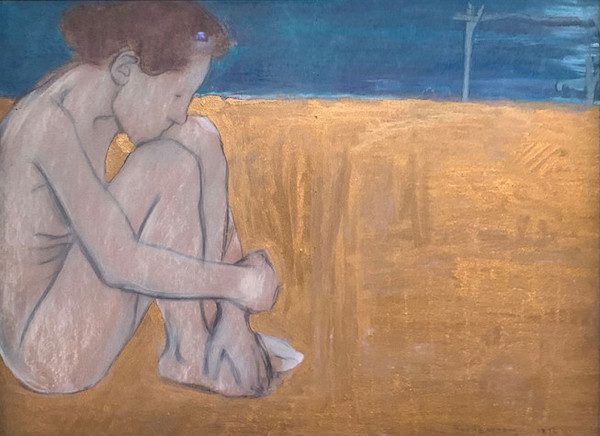
Don société des Amis du musée d’Orsay, 1992. © RMN-Grand Palais
One leaves this magnificent exhibition, which is a must-see, amazed by the vivacity of the lines, the freshness and purity of the colored shades that express a certain transience of being, redoubled by the fragility of the material. A praise to the painful beauty of the ephemeral perhaps?
Exhibition in Paris: Pastels de Millet à Redon
Musée d’Orsay. Now on till July 2nd 2023
WUKALI is a French Art and Culture magazine with free access on internet https://wukali.com (click)
You’ll find a broad range of topics: from history of art to exhibitions, books review, political sciences debates or animation movies, sciences, cultural news and even more… Besides some articles are translated in English.
Great, you may connect on WUKALI anytime just as you like it.
Would you like to contact us, and even more to write in WUKALI, feel free to do so !
Contact us : redaction@wukali.com (click)


